The Leadership Landscape Has Shifted. Are You Keeping Up With the Change?
In the space of just a few years, the professional world has turned upside down. Sudden changes in how, when, and where we work have forced a reevaluation of ‘business as usual’ and redefined decades-old concepts, ranging from the nine-to-five and the daily commute, to the corporate ladder and even the idea of the career itself.
Leaders have not gone unaffected by this disruption. In the face of this widespread uncertainty, they’re increasingly expected to be managers of change, cultivators of culture, connectors of remote teams, a source of support and answers, and alleviators of anxiety. In line with this, a new GetSmarter survey of 1,272 people from 103 countries reveals that no fewer than 87% of respondents have shifted their perspective on leadership in recent years. This includes seasoned leaders who have overseen teams for several years.
Four in five professionals with over 15 years of management experience agree that the leadership landscape has fundamentally changed.
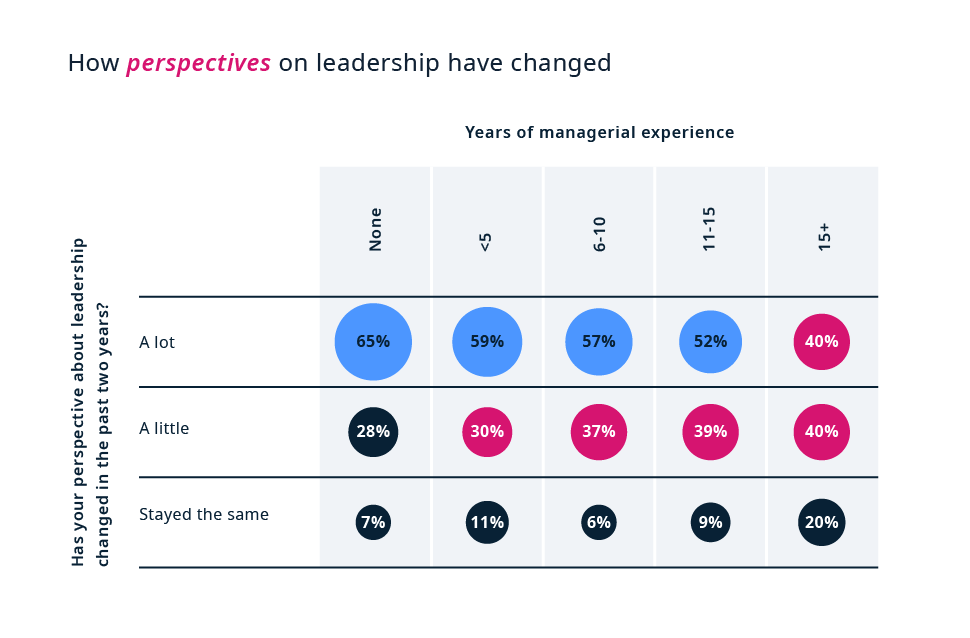
Explore the meaning of this change for you and your leadership style – and uncover tools and tips for how best you should navigate it – in this article.
What is leadership in a changing landscape?
Organizational leadership has typically been equated with higher-level employees making executive decisions, setting goals, and providing direction to the rest of the team.1 Most companies have traditionally tended towards this hierarchical, autocratic approach, whereby the CEO or their equivalent charts an overall course for the rest to follow.2 As a result, leadership has long been associated with authority and the transaction of punishment and reward – viewed as a position of power to be reached by only a few.
But occupying a leadership role is not the same thing as leading – and anyone has the capacity to develop the skills to excel in the latter.3 Where once leadership simply looked like a title to be attained, today, 89% of GetSmarter respondents believe that it’s an ongoing, dynamic process. And as many as 92% agree that leadership should no longer be regarded purely as an end destination, but as a journey of continual learning, reflection, and development.
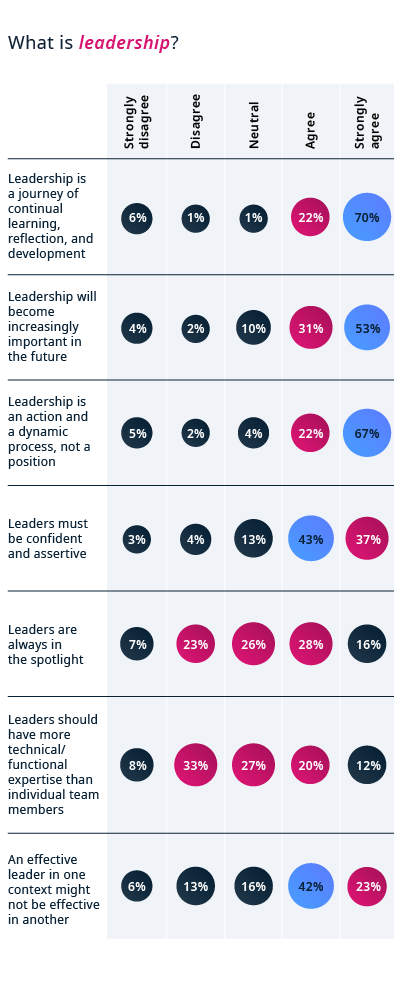
In other words, leadership isn’t merely about telling people what to do, but curating an environment – for oneself and for others – in which continuous learning can take root and thrive. Deborah Ancona, Faculty Director in the Leadership in an Exponentially Changing World online short course from the MIT Sloan School of Management, explains how leading in an uncertain and volatile world requires continuous learning and adaptation:
This shifting definition of leadership demands a reevaluation of where leaders place their focus, what leadership qualities they prioritize, and how they choose to develop and upskill themselves.
The trends redefining the future of leadership
At the turn of 2022, an estimated one in five employees signaled their intention to switch employers in the coming year in what has been dubbed the ‘great resignation’.4 Indeed, in the year prior, a record 48 million Americans quit their jobs (up 23% from pre-pandemic levels),5 while resignations in the United Kingdom, France, and other European nations also reached an all-time high.6
These departures left a huge hole in the labor market, with job openings exceeding new hires by up to 4.6 million in the US alone.7 Globally, three in four employers have reported difficulty in finding the skilled people that they need in a talent shortage that’s at a 16-year high.8 The result has been a seismic shift from a demand- to a supply-based talent economy, where workers hold all the cards and organizations must fill the void.
It’s thus unsurprising that respondents across almost every level of seniority in GetSmarter’s research agree that the availability of key talent is the number one factor currently disrupting organizational and leadership agendas. Simply put, there aren’t enough skilled people to do the work that’s required – from the coalface of small business,9 to the cutting-edge of the Fortune 500.10
Furthermore, our research indicates that many professionals assume that this crisis in human talent will prove to be just a short-term concern. When GetSmarter asked respondents to predict the top three trends that will be of most importance in the years ahead, the most frequently provided answers were:
- Accelerated digitization and automation
- Future-proofing by building organizational capability, agility, and resilience
While the least popular responses were:
- Enabling human connection and adopting a people-centric approach
- Shifting power dynamics and the employment relationship
- Embracing stakeholder capitalism
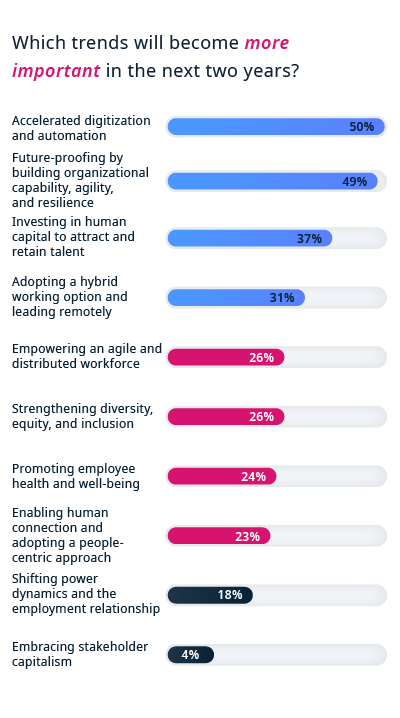
Organizations mustn’t underestimate the magnitude and longevity of this paradigm shift for human talent, where professionals seek out new pastures and new skills with increasing vigor.
While technology and automation are undoubtedly vital areas of investment, it’s imperative that leaders also commit to bringing people into the mix.
Enhance your ability to lead effectively through volatility and uncertainty.
After all, the skills gap can only be bridged when leaders recognize why their people are leaving in the first place, and the indications are that many quit because they don’t feel valued or understood by their managers.11 Additionally, it’s a mistake to assume that technological innovation can be realized without the human factor – even digital transformation is, at its heart, people-led. And, quite simply, the fallout from the talent crisis is of such a scale that it cannot be ignored: Three in four executives state that the ‘great resignation’ has negatively impacted their financial stability,12 as replacing an employee can cost an organization up to 200% of that individual’s salary.13 For leaders today, the message is clear: Talent retention has never been more important, making upskilling and reskilling the new priority, and the time to change the face of leadership is now.
Why authentic, inclusive leadership is important
Three years prior to the onset of COVID-19, a survey of professionals found that alongside integrity, attributes such as decisiveness, fairness, and a strategic mindset were considered the most important for leaders.14 Another survey conducted in the same year revealed that the ability to establish goals and objectives with clear direction was highly important.15 Companies have long tended to look for domineering, overwhelmingly ‘masculine’ attributes in their leaders, including self-aggrandizement, aggression, and ruthless, raw ambition.16 As a result, the traditional view of a leader in the corporate realm is that of a stern or extraordinarily charismatic commander-in-chief, making cool decisions based purely on profit and loss.17
Yet while some of these quintessential leadership attributes, such as decisiveness and strategic know-how, are not without worth, the research suggests a shift in values. In the post-pandemic world, the hard-charging, profit-chasing hero-leader has lost much of its appeal.18 Instead, when GetSmarter asked survey respondents to describe the single most important characteristic of an effective leader using one word, some of the most common answers given were:
- Empathy (40 mentions)
- Inspiring (40 mentions)
- Authentic (30 mentions)
- Trust (20 mentions)
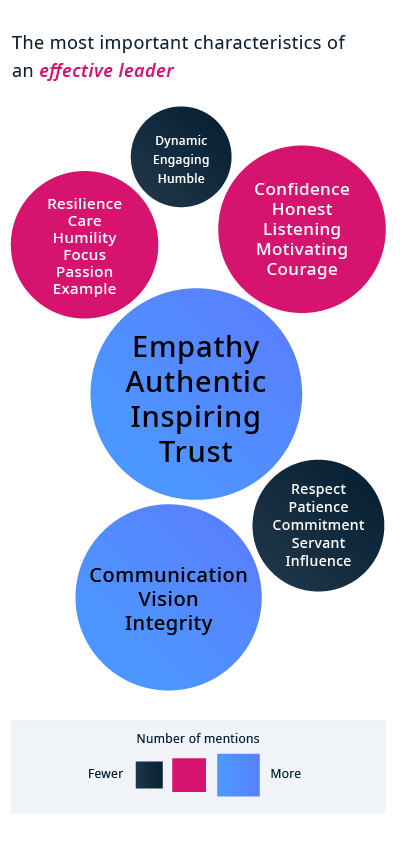
These words paint a very different picture to the traditional view of a leader. Notably, none of these responses mention a leader’s qualifications, intelligence, or knowledge. Nor do they speak to authority, control, or power. In today’s workplace, employees look to ethical, empathetic leaders who understand and connect with their emotional needs, are relatable and vulnerable in helping them weather anxiety or isolation, and embody attributes that may once have been regarded as essentially ‘feminine’.19 Gartner research reinforces this message, citing empathy, adaptability, and authenticity as the components that hold the key to effective human leadership today.20 All three have the power to enhance relationships, foster trust, and build a more positive work environment.
Explore the paradox between authenticity and adaptability in leadership.
GetSmarter’s survey suggests that respondents who identify as a minority value authenticity above any other attribute (whereas those who don’t, place inspiration at the top of the pile). This may indicate that while efforts to promote diversity and inclusion have visibly climbed the corporate agenda, leaders’ actions will always speak louder than words. Lip service towards people of color and other minority groups tends to be viewed as just that, unless leaders are truly authentic in their approach.
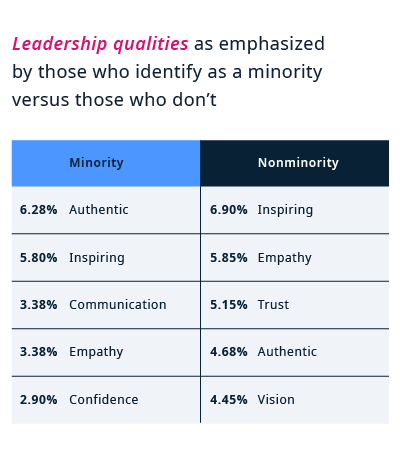
Gain practical tools to promote diversity, equity, and inclusion in the workplace.
Furthermore, respondents who identify as female have always tended to prioritize empathy, honesty, authenticity, communication, and serving as an inspiration to others more than those who identify as male (who particularly value trust and vision).
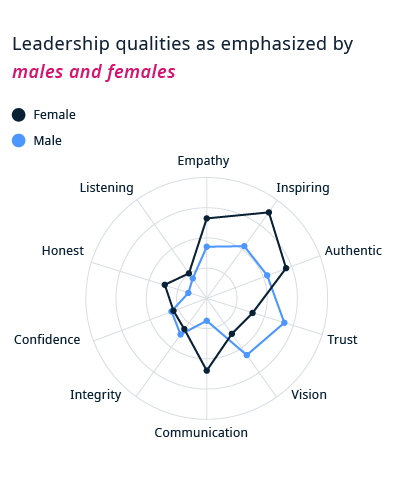
Harness your unique strengths and emotional intelligence as a woman leader to guide your team to success.
Moving forward, the onus is on all leaders to foster these attributes and emerge as emotionally intelligent, transformational, and purpose-led allies to their employees. After all, ‘uncaring leaders’ is the number one reason why employees will leave a job without another in hand.21
The responsibilities of the future-ready leader
At the same time, the perceptions of a leader’s most critical role and responsibilities have shifted. Where once the yardstick for effective leadership was predominantly driving strategy, managing operations, and boosting the bottom line,22 leaders are now expected to put their people first.
According to GetSmarter’s research, the most important roles and responsibilities of today’s leader are:
- Growing and developing people
- Creating and articulating a clear vision/purpose
- Influencing and motivating others
Against the backdrop of the ‘great resignation’, where employees expect opportunities for upskilling or are liable to take their talents elsewhere, leaders must play an active role in building an environment that enables personal and professional growth.
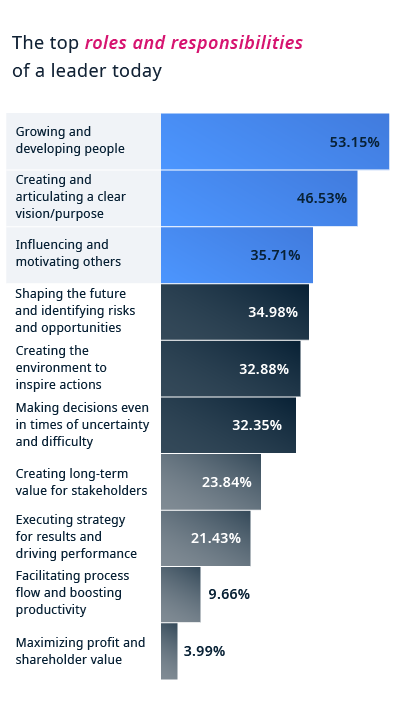
The lessons for leaders
There may, however, still be some confusion within the corridors of power regarding what employees really want from their seniors. When GetSmarter asked leaders and HR representatives what employees seek most from leadership, the answer returned was the same: recognition and appreciation. However, pose this question to employees themselves and the picture shifts. GetSmarter’s research found that most individuals value clear communication from their leaders above all else (cited by 61% of respondents). Leaders also underestimate the importance of honest feedback and respect to their direct reports, as authentic leadership is contingent on these factors. Essentially, today’s employee would rather hear the uncomfortable truth than fulsome praise.
Gain effective communication skills to motivate diverse and dispersed teams.
This matters because leaders who treat others with dignity, maintain transparent lines of communication, and foster a sense of belonging are 16 times more likely to earn and keep the trust of others.23 And in an age of instability, where remote models of work could call for a more hands-off or ‘laissez faire’ leadership approach and major corporate restructuring may lie just around the corner, trust has never been more important.
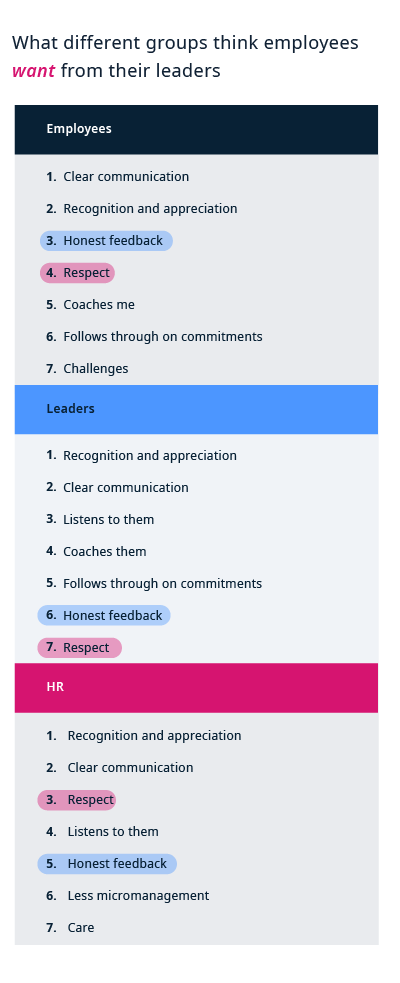
New models of leadership
As the workplace is reinvented, a new model of leadership has emerged. To navigate the future of work, all leaders must update their skill set and recognize the growing importance of traits such as emotional intelligence, self-awareness, and accountability.
In the second part of this blog series, you’ll discover how you can ready yourself for this new normal by upskilling across a handful of core competencies.
- 1 (May, 2022). ‘What is business leadership? Definition, skills of effective leaders’. Retrieved from Indeed.
- 2 Dorazio, J. (Apr, 2022). ‘The business case for nurturing a culture of leadership’. Retrieved from Forbes.
- 3 Velcour, M. (Nov, 2020). ‘Anyone can learn to be a better leader’. Retrieved from the Harvard Business Review.
- 4 (2022). ‘What 52,000 people think about work today’. Retrieved from PwC.
- 5 Iacurci. G. (Mar, 2022). ‘4.3 million people quit their jobs in January as the Great Resignation shows no sign of slowing down’. Retrieved from CNBC.
- 6 Carbonaro, G. (May, 2022). ‘No end in sight for the “Great Resignation” as inflation pushes workers to seek better-paid jobs’. Retrieved from Euro News.
- 7 De Smet, A. et al. (Mar, 2022). ‘Gone for now, or gone for good? How to play the new talent game and win back workers’. Retrieved from McKinsey.
- 8 (2022). ‘ManpowerGroup employment outlook survey’. Retrieved from ManpowerGroup.
- 9 Thomas, I. (Mar, 2022). ‘Big February job growth for economy, but on Main Street it’s still a struggle to find workers’. Retrieved from CNBC.
- 10 Murray, A. (May, 2022). ‘Fortune 500 CEO survey: The leaders of America’s biggest companies are bracing for a recession’. Retrieved from Fortune.
- 11 De Smet, A. et al. (Sep, 2021). ‘“Great Attrition” or “Great Attraction”? The choice is yours’. Retrieved from McKinsey.
- 12 (2022). ‘The state of talent optimization’. Retrieved from The Predictive Index.
- 13 Mosley, E. (Oct, 2021). ‘This is the cost of the Great Resignation. Here’s what leaders can do’. Retrieved from Fast Company.
- 14 (Sep, 2016). ‘What is the most important leadership attribute?’. Retrieved from Robert Half.
- 15 Giles, S. (Mar, 2016). ‘The most important leadership competencies, according to leaders around the world’. Retrieved from the Harvard Business Review.
- 16 Jackson, M. and Rajai, P. (Jan, 2021). ‘Does your definition of leadership exclude women of color?’. Retrieved from the Harvard Business Review.
- 17 Bonnell, S. and Hansberger, A. (Jan, 2022). ‘Traditional leadership is dead. This is what will take its place’. Retrieved from Fast Company.
- 18 Joly, H. (Apr, 2022). ‘5 principles of purposeful leadership’. Retrieved from the Harvard Business Review.
- 19 Bonnell, S. and Hansberger, A. (Jan, 2022). ‘Traditional leadership is dead. This is what will take its place’. Retrieved from Fast Company.
- 20 (Jun, 2022). ‘Gartner HR research identifies human leadership as the next evolution of leadership’. Retrieved from Gartner.
- 21 De Smet, A. (Mar, 2022). ‘Gone for now, or gone for good? How to play the new talent game and win back workers’. Retrieved from McKinsey.
- 22 (2019). ‘Leading the social enterprise: Reinvent with a human focus’. Retrieved from Deloitte.
- 23 Carucci, R. (Jun, 2021). ‘Build your reputation as a trustworthy leader’. Retrieved from the Harvard Business Review.